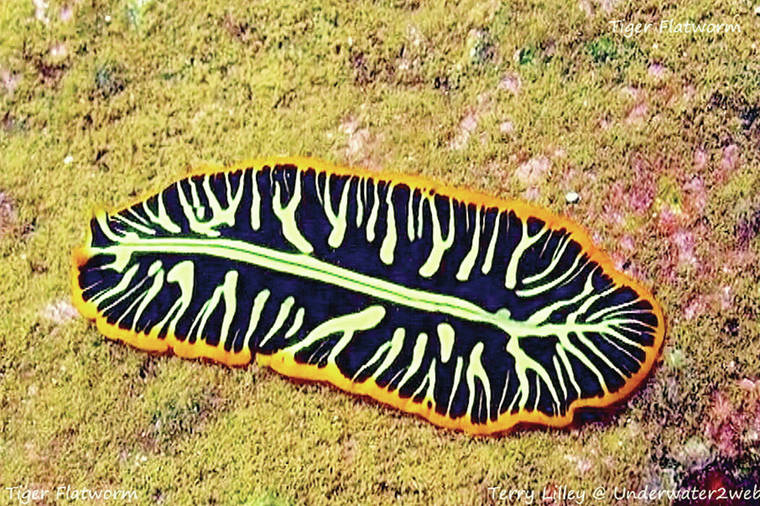We have lots of strange creatures that live out on our coral reefs here in Hawai‘i, but the tiger flatworm ranks as one of the most bizarre. This three-inch-long, very-colorful creature crawls across the reef during the day and is highly poisonous. It contains in its skin tetrodotoxin, which is the same poison that our pufferfish have in their skin.
We have lots of strange creatures that live out on our coral reefs here in Hawai‘i, but the tiger flatworm ranks as one of the most bizarre. This three-inch-long, very-colorful creature crawls across the reef during the day and is highly poisonous. It contains in its skin tetrodotoxin, which is the same poison that our pufferfish have in their skin.
The best place to find these flatworms is inside of harbors and jetties, crawling on the rocks in search of food, which consists of small invertebrates and even each other. As far as we know the Hawaiian tiger flatworm is a new species and is not even classified yet with a scientific name. Our ocean is still filled with creatures yet to be discovered and named.
Flatworms are thought to be very ancient and may be the first animals on Earth to evolve with bilateral symmetry. This is when the left and right sides mirror each other, and it has a distinct head and tail. These strange sea creatures breathe through their skin and do not have a body cavity, and their mouth is also their anus. They have a soft body and tiny eye spots for use to see where they are going.
Most flatworms are parasites living their entire life inside of other animals like the human tapeworm, so why this one evolved to live out on the coral reef is quite a mystery.
Like the tapeworm, the tiger flatworm is hard to kill. If you cut it in half, each half will grow back and you will have two flatworms. If you cut the head off it will grow a new head, and if you cut the head in half it will grow two new heads.
The flatworms are both males and females in the same body, and they have several ways to reproduce. They can mate with themselves, mate with other flatworms or just split in half and make two flatworms.
Due to their secretive nature, the marine flatworms are not well studied, and a lot is still not known about their behavior and evolution. While scuba diving I sometimes see three or four of these bright-colored creatures crawling around on the rocks, then I won’t see another one for years. We simply don’t know if they move from shallow into deep water or even if they lay eggs that may float away on the currents to repopulate a different part of the reef.
You can see the tiger flatworm in action in the movie “The World’s Guide To Hawaiian Reef Creatures” at underwater2web@gmail.com, and also follow my weekly marine-life educational post on my Facebook and Instagram under my name.
•••
Terry Lilley is a marine biologist living in Hanalei and a co-founder of Reef Guardians Hawai‘i, a nonprofit on a mission to provide education and resources to protect the coral reef. To donate to Reef Guardians Hawaii go to reefguardianshawaii.org.




